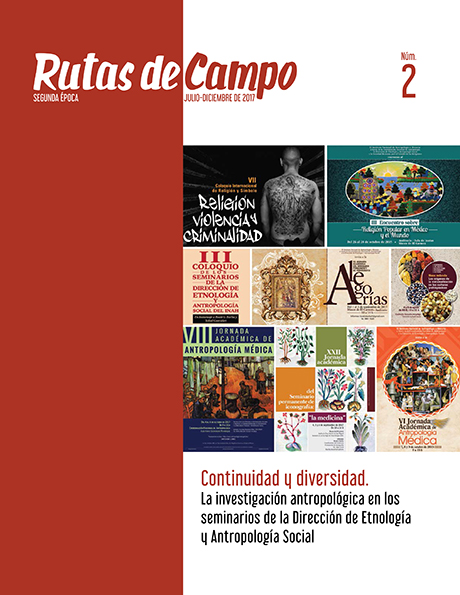Artículos
Published 2017-12-29
Keywords
- Agentividad,
- Cultura,
- Lingüística,
- Semiótica,
- Relativismo
How to Cite
La agentividad: entre las lenguas y la cultura. (2017). Field Routes, 2, 45-61. https://revistas.inah.gob.mx/index.php/rutasdecampo/article/view/12449
Abstract
No se cuenta con resumen.
Downloads
Download data is not yet available.
References
Camargo, Eliane (2013). “Agentivité grammaticale et agentivité intrinsèque”. En Aurore Monod Becquelin, Valentina Vapnarsky y Michel de Fornel (eds.). Ateliers d’anthropologie, 39. doi: 10.4000/ateliers
Dobres, Marcia A., y Robb, John E. (eds.) (2000). Agency in Archaeology. Londres: Routledge.
Duranti, Alessandro (ed.) (2004). A Companion to Linguistic Anthropology. Malden: Blackwell Publishing.
Fontaine, Laurent (2010). “’Agents’ ou ‘patients’?”. En Aurore Monod Becquelin y Valentina Vapnarsky (eds.). Ateliers d’anthropologie, 34. doi: 10.4000/ateliers.8526
Greimas, Algirdas Julien, y Courtès, Joseph (1982). Semiótica. Diccionario razonado de la teoría del lenguaje. Madrid: Gredos.
Gutierrez Choquevilca, Andréa-Luz (2010). “Imaginaire acoustique et apprentissage d’une ontologie animiste”. En Aurore Monod Becquelin y Valentina Vapnarsky (eds.). Ateliers d’anthropologie, 34. doi: 10.4000/ateliers.8553
Hill, Jane (1988). “Language, Culture, and World View”. En Frederick J. Newmeyer (ed.). Linguistics: The Cambridge Survey, 4. Language: The Socio-cultural Context (pp. 14-36). Cambridge: Cambridge University Press.
Kull, Kalevi (2015). “Semiosis Stems from Logical Incompatibility in Organic Nature: Why Biophysics Does Not See Meaning, While Biosemiotics Does”. Progress in Biophysics and Molecular Biology, 119 (3), pp. 616-621.
Landowski, Eric (2009). “Avoir prise, donner prise”. Actes Sémiotiques, 112. Recuperado de: http://epublications.unilim.fr/revues/as/2852
Langacker, Ronald W. (2000). Grammar and Conceptualization. Berlín-Nueva York: Mouton de Gruyter.
Levinson, Stephen C. (2003). Space in Language and Cognition: Explorations in Cognitive Diversity. Cambridge: Cambridge University Press.
Lucy, John A. (1992). Language Diversity and Thought: A Reformulation of the Linguistic Relativity Hypothesis. Cambridge: Cambridge University Press.
Monod Becquelin, Aurore, y Becquey, Cédric (2013). “Transitivité de l’action et ses expressions en trumai (langue isolée du Haut Xingú, Brésil)”. En Valentina Vapnarsky, Aurore Monod Becquelin y Michel de Fornel eds.). Ateliers d’anthropologie, 39. doi: 10.4000/ateliers.9478
Paz, Octavio (2014). Obra poética (1935-1998). Barcelona: Galaxia Gutenberg.
Tylén, Kristian (2007). “When Agents Become Expressive: A Theory of Semiotic Agency”. En Lars Andreassen, Line Brandt y Jes Vang Overgaard (eds.). Cognitive Semiotics, 1 (pp. 84-101).
Van Valin, Robert D. Jr., y LaPolla, Randy J. (1997). Syntax: Structure, Meaning and Function. Cambridge: Cambridge University Press.
Whorf, Benjamin L. (1956/1971). Lenguaje, pensamiento y realidad (José M. Pomares, trad.). Barcelona: Barral.
Yamamoto, Mutsumi (2006). Agency and Impersonality. Amsterdam: John Benjamins Publishing Company.
Dobres, Marcia A., y Robb, John E. (eds.) (2000). Agency in Archaeology. Londres: Routledge.
Duranti, Alessandro (ed.) (2004). A Companion to Linguistic Anthropology. Malden: Blackwell Publishing.
Fontaine, Laurent (2010). “’Agents’ ou ‘patients’?”. En Aurore Monod Becquelin y Valentina Vapnarsky (eds.). Ateliers d’anthropologie, 34. doi: 10.4000/ateliers.8526
Greimas, Algirdas Julien, y Courtès, Joseph (1982). Semiótica. Diccionario razonado de la teoría del lenguaje. Madrid: Gredos.
Gutierrez Choquevilca, Andréa-Luz (2010). “Imaginaire acoustique et apprentissage d’une ontologie animiste”. En Aurore Monod Becquelin y Valentina Vapnarsky (eds.). Ateliers d’anthropologie, 34. doi: 10.4000/ateliers.8553
Hill, Jane (1988). “Language, Culture, and World View”. En Frederick J. Newmeyer (ed.). Linguistics: The Cambridge Survey, 4. Language: The Socio-cultural Context (pp. 14-36). Cambridge: Cambridge University Press.
Kull, Kalevi (2015). “Semiosis Stems from Logical Incompatibility in Organic Nature: Why Biophysics Does Not See Meaning, While Biosemiotics Does”. Progress in Biophysics and Molecular Biology, 119 (3), pp. 616-621.
Landowski, Eric (2009). “Avoir prise, donner prise”. Actes Sémiotiques, 112. Recuperado de: http://epublications.unilim.fr/revues/as/2852
Langacker, Ronald W. (2000). Grammar and Conceptualization. Berlín-Nueva York: Mouton de Gruyter.
Levinson, Stephen C. (2003). Space in Language and Cognition: Explorations in Cognitive Diversity. Cambridge: Cambridge University Press.
Lucy, John A. (1992). Language Diversity and Thought: A Reformulation of the Linguistic Relativity Hypothesis. Cambridge: Cambridge University Press.
Monod Becquelin, Aurore, y Becquey, Cédric (2013). “Transitivité de l’action et ses expressions en trumai (langue isolée du Haut Xingú, Brésil)”. En Valentina Vapnarsky, Aurore Monod Becquelin y Michel de Fornel eds.). Ateliers d’anthropologie, 39. doi: 10.4000/ateliers.9478
Paz, Octavio (2014). Obra poética (1935-1998). Barcelona: Galaxia Gutenberg.
Tylén, Kristian (2007). “When Agents Become Expressive: A Theory of Semiotic Agency”. En Lars Andreassen, Line Brandt y Jes Vang Overgaard (eds.). Cognitive Semiotics, 1 (pp. 84-101).
Van Valin, Robert D. Jr., y LaPolla, Randy J. (1997). Syntax: Structure, Meaning and Function. Cambridge: Cambridge University Press.
Whorf, Benjamin L. (1956/1971). Lenguaje, pensamiento y realidad (José M. Pomares, trad.). Barcelona: Barral.
Yamamoto, Mutsumi (2006). Agency and Impersonality. Amsterdam: John Benjamins Publishing Company.

